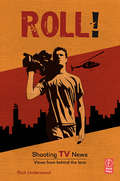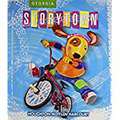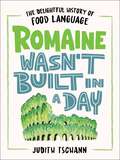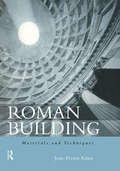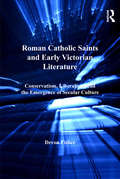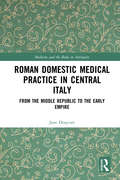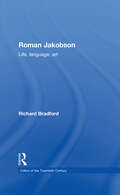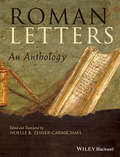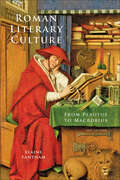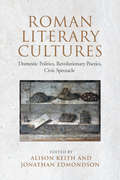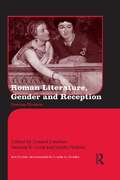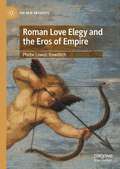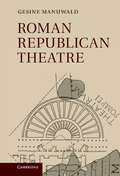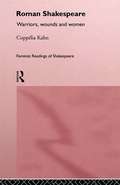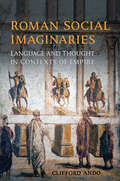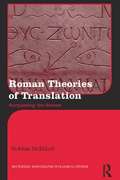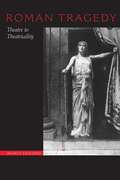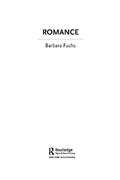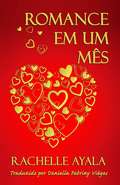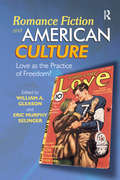- Table View
- List View
Roll! Shooting TV News: Views from Behind the Lens
by Rich UnderwoodRoll! Shells fly overhead as night-scopes capture deadly fire fights with an eerie green hue, a category 5 hurricane devastates the Big Easy, hidden cameras enter a Cambodian village of brothels and a veteran journalist interviews himself throughout his own brain surgery. Part non-fiction drama, part trade publication, part text book, all woven together giving the reader a look through the viewfinders of the very best television photojournalists. As 19 experts weigh in with their candid, personal stories and photographic tips, it's as if you're over their shoulders, following their intuitions and hearing their thoughts as they shoot. The trade term for what they do is called ENG (Electronic News Gathering) and whether they're called Cameramen, Backpack Journalists, Television Photographers or any other moniker de jour, they're all paid to bring the world's events into living rooms around the world. These are the men and women who capture the bleeding edge of history - as it happens.Written in a smooth, unique interview style, this book is a necessary read for photojournalists, videographers and tv photojournalists.
Romaine Wasn't Built in a Day: The Delightful History of Food Language
by Judith Tschann"A truly delightful smorgasbord of history and linguistics that kept us entertained—and made us hungry."—Apple Books "Scrumptious...This book was meant to be devoured." —Roy Peter Clark, author of Murder Your DarlingsRomaine calm and read on for a deliciously detailed digest of food language throughout time from celebrated linguist and historian Judith Tschann that is guaranteed to "make you a hit at dinner parties" (New York Times). Food and words—we rely on both to sustain our daily lives. We begin each morning hungry for nourishment and conversation, and our happiest moments and fondest memories are often filled with ample servings of both. Food historian Judith Tschann celebrates this glorious intersection of linguistic and culinary affinities with Romaine Wasn't Build in a Day, an irresistibly charming and deliciously decadent romp through the history of food words. On the hunt for the hidden stories behind hundreds of dishes and ingredients we take for granted, Tschann takes us on an expedition through the centuries and around the world, illuminating the ways in which language is always changing, ever-amusing, and entirely inseparable from culture, history, identity, and such as: pumpernickel, which literally means "Farting Nicholas" the surprising linguistic connection between alcohol and eyeliner and the fascinating travels of the word coffee across centuries and continents, attesting to the enduring allure of a cuppa joe Full of endless morsels of fascination for word nerds and foodies alike, Romaine Wasn't Built in a Day will beguile history buffs, captivate crossword fiends, satiate Scrabble nerds, and feed our fondness for our two favorite pastimes: eating and talking.
Roman Building: Materials and Techniques
by Jean-Pierre AdamWith over 750 illustrations, Roman Buildings is a thorough and systematic examination of Roman architecture and building practice, looking at large-scale public buildings as well as more modest homes and shops. Placing emphasis on the technical aspects of the subject, the author follows the process of building through each stage -- from quarry to standing wall, from tree to roof timbers -- and describes how these materials were obtained or manufactured. The author also discusses interior decoration and looks at the practical aspects of water supply, heating and roads.
Roman Catholic Saints and Early Victorian Literature: Conservatism, Liberalism, and the Emergence of Secular Culture
by Devon FisherOffering readings of nineteenth-century travel narratives, works by Tractarians, the early writings of Charles Kingsley, and the poetry of Alfred Tennyson, Devon Fisher examines representations of Roman Catholic saints in Victorian literature to assess both the relationship between conservative thought and liberalism and the emergence of secular culture during the period. The run-up to Victoria's coronation witnessed a series of controversial liberal reforms. While many early Victorians considered the repeal of the Test and Corporation Acts (1828), the granting of civil rights to Roman Catholics (1829), and the extension of the franchise (1832) significant advances, for others these three acts signaled a shift in English culture by which authority in matters spiritual and political was increasingly ceded to individuals. Victorians from a variety of religious perspectives appropriated the lives of Roman Catholic saints to create narratives of English identity that resisted the recent cultural shift towards private judgment. Paradoxically, conservative Victorians' handling of the saints and the saints' lives in their sheer variety represented an assertion of individual authority that ultimately led to a synthesis of liberalism and conservatism and was a key feature of an emergent secular state characterized not by disbelief but by a range of possible beliefs.
Roman Domestic Medical Practice in Central Italy: From the Middle Republic to the Early Empire (Medicine and the Body in Antiquity)
by Jane DraycottRoman Domestic Medical Practice in Central Italy examines the roles that the home, the garden and the members of the household (freeborn, freed and slave) played in the acquisition and maintenance of good physical and mental health and well-being. Focussing on the period from the middle Republic to the early Empire, it considers how comprehensive the ancient Roman general understanding of health actually was, and studies how knowledge regarding various aspects of health was transmitted within the household. Using literary, documentary, archaeological and bioarchaeological evidence from a variety of contexts, this is the first extended volume to provide as comprehensive and detailed a reconstruction of this aspect of ancient Roman private life as possible, complementing existing works on ancient professional medical practice and existing works on domestic medical practice in later historical periods. This volume offers an indispensable resource to social historians, particularly those that focus on the ancient family, and medical historians, particularly those that focus on the ancient world.
Roman Jakobson: Life, Language and Art (Critics of the Twentieth Century)
by Richard BradfordIn Roman Jakobson Richard Bradford reasserts the value of Jakobson's work, arguing that he has a great deal to offer contemporary critical theory and providing a critical appraisal the sweep of Jakobson's career. Bradford re-establishes Jakobson's work as vital to our understanding of the relationship between language and poetry. By exploring Jakobson's thesis that poetry is the primary object language, Roman Jakobson: Life, Language, Art offers a new reading of his work which includes the most radical elements of modernism. This book will be invaluable to students of Jakobson and to anyone interested in the development of critical theory, linguistics and stylistics.
Roman Letters
by Noelle K. Zeiner-CarmichaelRoman Letters offers a rich selection of original translations of ancient Roman letters spanning from the 1st century BCE to the 2nd century CE. Chronologically arranged and grouped according to author or collection, the letters cover various topics and themes selected from a broad range of authors.A unique single volume text that makes classical letters accessible and readable to undergraduates and the non-specialist readerPresents a wide range of authors and material, with over 200 selected textsIncludes selections that illustrate a complete cycle of correspondence, as well as letters written by the same author and covering the same topic/theme but sent to different recipientsLetters are arranged chronologically, with letters grouped according to author or collectionAn accompanying website offers additional, complementary lettersTopical index highlights various topics and themes represented by the letters
Roman Literary Culture: From Plautus to Macrobius (Ancient Society and History)
by Elaine FanthamThis new edition broadens the scope of Fantham’s study of literary production and its reception in Rome.Scholars of ancient literature have often focused on the works and lives of major authors rather than on such questions as how these works were produced and who read them. In Roman Literary Culture, Elaine Fantham fills that void by examining the changing social and historical context of literary production in ancient Rome and its empire. Fantham’s first edition discussed the habits of Roman readers and developments in their means of access to literature, from booksellers and copyists to pirated publications and libraries. She examines the issues of patronage and the utility of literature and shows how the constraints of the physical object itself—the ancient "book"—influenced the practice of both reading and writing. She also explores the ways in which ancient criticism and critical attitudes reflected cultural assumptions of the time.In this second edition, Fantham expands the scope of her study. In the new first chapter, she examines the beginning of Roman literature—more than a century before the critical studies of Cicero and Varro. She discusses broader entertainment culture, which consisted of live performances of comedy and tragedy as well as oral presentations of the epic. A new final chapter looks at Pagan and Christian literature from the third to fifth centuries, showing how this period in Roman literature reflected its foundations in the literary culture of the late republic and Augustan age. This edition also includes a new preface and an updated bibliography.
Roman Literary Cultures: Domestic Politics, Revolutionary Poetics, Civic Spectacle
by Jonathan Edmondson Alison KeithDrawing on the historicizing turn in Latin literary scholarship, Roman Literary Cultures combines new critical methods with traditional analysis across four hundred years of Latin literature, from mid-republican Rome in the second century BC to the Second Sophistic in the second century AD. The contributors explore Latin texts both famous and obscure, from Roman drama and Menippean satire through Latin elegies, epics, and novels to letters issued by Roman emperors and compilations of laws.Each of the essays in this volume combines close reading of Latin literary texts with historical and cultural contextualization, making the collection an accessible and engaging combination of formalist criticism and historicist exegesis that attends to the many ways in which classical Latin literature participated in ancient Roman civic debates.
Roman Literature and its Contexts: Texts, editors, and readers
by Richard TarrantThis book re-examines the most traditional area of classical scholarship, offering critical assessments of the current state of the field, its methods and controversies, and its prospects for the future in a digital environment. Each stage of the editorial process is examined, from gathering and evaluating manuscript evidence to constructing the text and critical apparatus, with particular attention given to areas of dispute, such as the role of conjecture. The importance of subjective factors at every point is highlighted. An Appendix offers practical guidance in reading a critical apparatus. The discussion is framed in a way that is accessible to non-specialists, with all Latin texts translated. The book will be useful both to classicists who are not textual critics and to non-classicists interested in issues of editing.
Roman Literature, Gender and Reception: Domina Illustris (Routledge Monographs in Classical Studies #13)
by Donald Lateiner Barbara K. Gold Judith PerkinsThis cutting-edge collection of essays offers provocative studies of ancient history, literature, gender identifications and roles, and subsequent interpretations of the republican and imperial Roman past. The prose and poetry of Cicero and Petronius, Lucretius, Virgil, and Ovid receive fresh interpretations; pagan and Christian texts are re-examined from feminist and imaginative perspectives; genres of epic, didactic, and tragedy are re-examined; and subsequent uses and re-uses of the ancient heritage are probed with new attention: Shakespeare, Nineteenth Century American theater, and contemporary productions involving prisoners and veterans. Comprising nineteen essays collectively honoring the feminist Classical scholar Judith Hallett, this book will interest the Classical scholar, the ancient historian, the student of Reception Studies, and feminists interested in all periods. The authors from the United States, Britain, France and Switzerland are authorities in one or more of these fields and chapters range from the late Republic to the late Empire to the present.
Roman Love Elegy and the Eros of Empire (The New Antiquity)
by Phebe Lowell BowditchThis book explores Roman love elegy from postcolonial perspectives, arguing that the tropes, conventions, and discourses of the Augustan genre serve to reinforce the imperial identity of its elite, metropolitan audience. Love elegy presents the phenomena and discourses of Roman imperialism—in terms of visual spectacle (the military triumph), literary genre (epic in relation to elegy), material culture (art and luxury goods), and geographic space—as intersecting with ancient norms of gender and sexuality in a way that reinforces Rome’s dominance in the Mediterranean. The introductory chapter lays out the postcolonial frame, drawing from the work of Edward Said among other theorists, and situates love elegy in relation to Roman Hellenism and the varied Roman responses to Greece and its cultural influences. Four of the six subsequent chapters focus on the rhetorical ambivalence that characterizes love elegy’s treatment of Greek influence: the representation of the domina or mistress as simultaneously a figure for ‘captive Greece’ and a trope for Roman imperialism; the motif of the elegiac triumph, with varying figures playing the triumphator, as suggestive of Greco-Roman cultural rivalry; Rome’s competing visions of an Attic and an Asiatic Hellenism. The second and the final chapter focus on the figures of Osiris and Isis, respectively, as emblematic of Rome’s colonialist and ambivalent representation of Egypt, with the conclusion offering a deconstructive reading of elegy’s rhetoric of orientalism.
Roman Republican Theatre
by Gesine ManuwaldTheatre flourished in the Roman Republic, from the tragedies of Ennius and Pacuvius to the comedies of Plautus and Terence and the mimes of Laberius. Yet apart from the surviving plays of Plautus and Terence the sources are fragmentary and difficult to interpret and contextualise. This book provides an up-to-date and comprehensive history of all aspects of the topic, incorporating recent findings and modern approaches. It discusses the origins of Roman drama and the historical, social and institutional backgrounds of all the dramatic genres to be found during the Republic (tragedy, praetexta, comedy, togata, Atellana, mime and pantomime). Possible general characteristics are identified, and attention is paid to the nature of and developments in the various genres. The clear structure and full bibliography also ensure that the book has value as a source of reference for all upper-level students and scholars of Latin literature and ancient drama.
Roman Satire and the Old Comic Tradition
by Jennifer L. Ferriss-HillQuintilian famously claimed that satire was tota nostra, or totally ours, but this innovative volume demonstrates that many of Roman Satire's most distinctive characteristics derived from ancient Greek Old Comedy. Jennifer L. Ferriss-Hill analyzes the writings of Lucilius, Horace, and Persius, highlighting the features that they crafted on the model of Aristophanes and his fellow poets: the authoritative yet compromised author; the self-referential discussions of poetics that vacillate between defensive and aggressive; the deployment of personal invective in the service of literary polemics; and the abiding interest in criticizing individuals, types, and language itself. The first book-length study in English on the relationship between Roman Satire and Old Comedy, Roman Satire and the Old Comic Tradition will appeal to students and researchers in classics, comparative literature, and English.
Roman Shakespeare: Warriors, Wounds and Women (Feminist Readings of Shakespeare)
by Coppélia KahnIn the first full-length study of Shakespeare's Roman plays, Coppélia Kahn brings to these texts a startling, critical perspective which interrogates the gender ideologies lurking behind 'Roman virtue'. Plays featured include: * Titus Andronicus * Julius Caesar * Antony and Cleopatra * Coriolanus * Cymbeline Setting the Roman works in the dual context of the popular theatre and Renaissance humanism, the author identifies new sources which she analyzes from a historicised feminist perspective. Roman Shakespeare is written in an accessible style and will appeal to scholars and students of Shakespeare and those interested in feminist theory, as well as classicists.
Roman Social Imaginaries
by Clifford AndoIn an expansion of his 2012 Robson Classical Lectures, Clifford Ando examines the connection between the nature of the Latin language and Roman thinking about law, society, and empire. Drawing on innovative work in cognitive linguistics and anthropology, Roman Social Imaginaries considers how metaphor, metonymy, analogy, and ideation helped create the structures of thought that shaped the Roman Empire as a political construct.Beginning in early Roman history, Ando shows how the expansion of the empire into new territories led the Romans to develop and exploit Latin's extraordinary capacity for abstraction. In this way, laws and institutions invented for use in a single Mediterranean city-state could be deployed across a remarkably heterogeneous empire.Lucid, insightful, and innovative, the essays in Roman Social Imaginaries constitute some of today's most original thinking about the power of language in the ancient world.
Roman Theories of Translation: Surpassing the Source (Routledge Monographs in Classical Studies)
by Siobhán McElduffFor all that Cicero is often seen as the father of translation theory, his and other Roman comments on translation are often divorced from the complicated environments that produced them. The first book-length study in English of its kind, Roman Theories of Translation: Surpassing the Source explores translation as it occurred in Rome and presents a complete, culturally integrated discourse on its theories from 240 BCE to the 2nd Century CE. Author Siobhán McElduff analyzes Roman methods of translation, connects specific events and controversies in the Roman Empire to larger cultural discussions about translation, and delves into the histories of various Roman translators, examining how their circumstances influenced their experience of translation. This book illustrates that as a translating culture, a culture reckoning with the consequences of building its own literature upon that of a conquered nation, and one with an enormous impact upon the West, Rome's translators and their theories of translation deserve to be treated and discussed as a complex and sophisticated phenomenon. Roman Theories of Translation enables Roman writers on translation to take their rightful place in the history of translation and translation theory.
Roman Tragedy: Theatre to Theatricality
by Mario ErasmoRoman tragedies were written for over three hundred years, but only fragments remain of plays that predate the works of Seneca in the mid-first century C.E., making it difficult to define the role of tragedy in ancient Roman culture. Nevertheless, in this pioneering book, Mario Erasmo draws on all the available evidence to trace the evolution of Roman tragedy from the earliest tragedians to the dramatist Seneca and to explore the role played by Roman culture in shaping the perception of theatricality on and off the stage.
Romance (The New Critical Idiom)
by Barbara FuchsOften derided as an inferior form of literature, 'romance' as a literary mode or genre defies satisfactory definition, dividing critics, scholars and readers alike. This useful guidebook traces the myriad transformations of 'romance' from medieval courtly love to Mills and Boon, and claims that its elusive and complex nature serves as a touchstone for larger questions of literary and cultural theory, such as: How does the history of 'romance' as a category force us to rethink the historicization of literary genres? What definitions can we provide for our own time to help us recognize and analyze new forms of 'romance'? To what extent is the resistance to romance a resistance to the imaginative force of literature? The case for 'romance' as a concept is presented clearly and imaginatively, arguing that its usefulness to contemporary critics can be maintained if it is regarded as a literary strategy rather than a fixed genre. In encouraging the reader to consider the fluidity of literature, Romance will be of equal value to all students of historical and comparative literatures and of modern literary forms.
Romance Em Um Mês
by Rachelle AyalaVocê gostaria de saber… •Como decifrar o código de um romance com um enredo único, moderno e contemporâneo? •Como ficar motivado para escrever e terminar suas ideias de histórias de romance? •Como os autores de sucesso escrevem de forma consistente e publicam trabalhos de alta qualidade em intervalos regulares? •Como usar personagens fortes e simpáticos e alcançar o sucesso das tramas de romances que são bem conhecidos para criar sua história de romance única? •Como um grupo de apoio de escritores pode motivar uns aos outros para que escrevam melhor e mais rápido? •Por que definir uma meta diária de contagem de palavras não é a melhor maneira de acompanhar seu progresso? •Como manter sua motivação, livro após livro e publicar regularmente? •Como fazer amizade com escritores e formar seu próprio grupo de escritores de romance para encorajar uns aos outros a se tornarem ainda mais incríveis? Neste livro, você aprenderá um método simples de escrever um romance em um curto período de tempo. Você também descobrirá por que escrever ao lado de um grupo de autores com ideias semelhantes é uma ótima maneira de aumentar sua produtividade, bem como elevar seu ânimo, e sem mencionar que ajuda e auxilia em sua jornada de escrita e publicação. Muito disso começa com você, suas crenças, desejos e fé em si mesmo. E então, junte isso a técnicas comprovadas e processos que funcionam e você pode levar sua escrita para o próximo nível, completar suas histórias de romance em um ritmo mais rápido e fazer isso regularmente. Romance Em Um Mês é um método de escrever um romance com a ajuda de uma comunidade de escritores. Nosso objetivo é permitir que você termine um romance de enredo único em apenas um mês de escrita e dar-lhe as técnicas para realizar isso repetidamente. Aprend
Romance Fiction and American Culture: Love as the Practice of Freedom?
by William A. Gleason and Eric Murphy SelingerSince the 1970s, romance novels have surpassed all other genres in terms of popularity in the United States, accounting for half of all mass market paperbacks sold and driving the digital publishing revolution. Romance Fiction and American Culture brings together scholars from the humanities, social sciences, and publishing to explore American romance fiction from the late eighteenth to the early twenty-first century. Essays on interracial, inspirational, and LGBTQ romance attend to the diversity of the genre, while new areas of inquiry are suggested in contextual and interdisciplinary examinations of romance authorship, readership, and publishing history, of pleasure and respectability in African American romance fiction, and of the dynamic tension between the genre and second wave feminism. As it situates romance fiction among other instances of American love culture, from Civil War diaries to Bob Dylan’s Blood on the Tracks, Romance Fiction and American Culture confirms the complexity and enduring importance of this most contested of genres.
Romance Languages
by Ti Alkire Carol RosenTi Alkire and Carol Rosen trace the changes that led from colloquial Latin to five major Romance languages, those which ultimately became national or transnational languages: Spanish, French, Italian, Portuguese, and Romanian. Trends in spoken Latin altered or dismantled older categories in phonology and morphology, while the regional varieties of speech, evolving under diverse influences, formed new grammatical patterns, each creating its own internal regularities. Documentary sources for spoken Latin show the beginnings of this process, which comes to full fruition in the medieval emergence of written Romance languages. This book newly distills the facts into an appealing program of study, including exercises, and makes the difficult issues clear, taking well motivated and sometimes innovative stands. It provides not only an essential guide for those new to the topic, but also a reliable compendium for the specialist.
